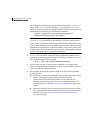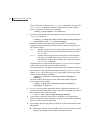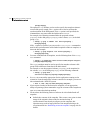
327Administering volume snapshots
Creating instant snapshots
Creating and managing full-sized instant snapshots
Note: Full-sized instant snapshots are not suitable for write-intensive volumes
(such as for database redo logs) because the copy-on-write mechanism may
degrade the performance of the volume.
For full-sized instant snapshots, you must prepare a volume that is to be used as
the snapshot volume. This must be the same size as the volume for which the
snapshot is being created, and it must also have the same region size. See
“Creating a volume for use as a full-sized instant or linked break-off snapshot”
on page 323 for details.
The attributes for a snapshot are specified as a tuple to the
vxsnap make
command. This command accepts multiple tuples. One tuple is required for each
snapshot that is being created. Each element of a tuple is separated from the
next by a slash character (/). Tuples are separated by white space.
To create and manage a full-sized instant snapshot
1 To create a full-sized instant snapshot, use the following form of the
vxsnap
make command:
# vxsnap [-g diskgroup] make source=volume/snapvol=snapvol\
[/snapdg=snapdiskgroup] [/syncing=off]
The command specifies the volume, snapvol, that you prepared earlier.
For example, to use the prepared volume, snap1myvol, as the snapshot for
the volume, myvol, in the disk group, mydg, use the following command:
# vxsnap -g mydg make source=myvol/snapvol=snap1myvol
For full-sized instant snapshots that are created from an empty volume,
background synchronization is enabled by default (equivalent to specifying
the
syncing=on attribute). If you want to move a snapshot into a separate
disk group, or to turn it into an independent volume, you must wait for its
contents to be synchronized with those of its parent volume.
You can use the
vxsnap syncwait command to wait for the synchronization
of the snapshot volume to be completed, as shown here:
# vxsnap [-g diskgroup] syncwait snapvol
For example, you would use the following command to wait for
synchronization to finish on the snapshot volume, snap2myvol:
# vxsnap -g mydg syncwait snap2myvol
This command exits (with a return code of zero) when synchronization of
the snapshot volume is complete. The snapshot volume may then be moved
to another disk group or turned into an independent volume.


















